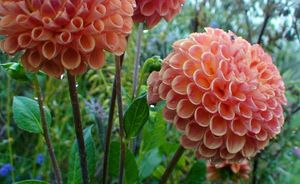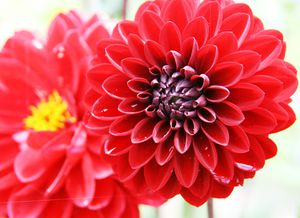Dahlia
| Dahlia | |
|---|---|

| |
| Scientific classification | |
| Kingdom: | Plantae |
| Order: | Asterales |
| Family: | Asteraceae |
| Subfamily: | Asteroideae |
| Tribe: | Coreopsideae |
| Genus: | Dahlia |
|
Dahlia counts over 30 species and some 20,000 cultivars | |
The dahlia plant comes originally from Mexico, Central America and Colombia. There exist over 30 species and many more hybrids that are grown as garden plants. Most of the species do not produce scented flowers, but the flowers are brightly colored.
Dahlias come from climates that do not experience frost. So when you grow dahlias in regions with cold winters, you need to take out the tubers from the soil before frost sets in and store them in cool and dry conditions during the winter. In spring you plant out these tubers again.
Dahlia plants prefer well-watered but free-draining soils and a location with full sunlight. All garden dahlias need pruning of the dead flower heads (deadheading).
Dahlias need a slightly acidic soil (pH 6.2 - 6.8). They grow in any soil but prefer a sandy clay loam with ample organic material in it. Because dahlias grow fast and develop much foliage, they need to be fertilized well with mature compost.
Dahlia tubers contain a naturally occurring fruit sugar, inulin, that was given to diabetics before the discovery of insulin in 1923.[1]
References
- ↑ Dahlia, section Scientific Applications Wikipedia
See also
External links
- Dahlia Wikipedia
- Let's talk soil Lobaugh's dahlias articles
Comments
- You need to be logged into your Facebook account to post comments

